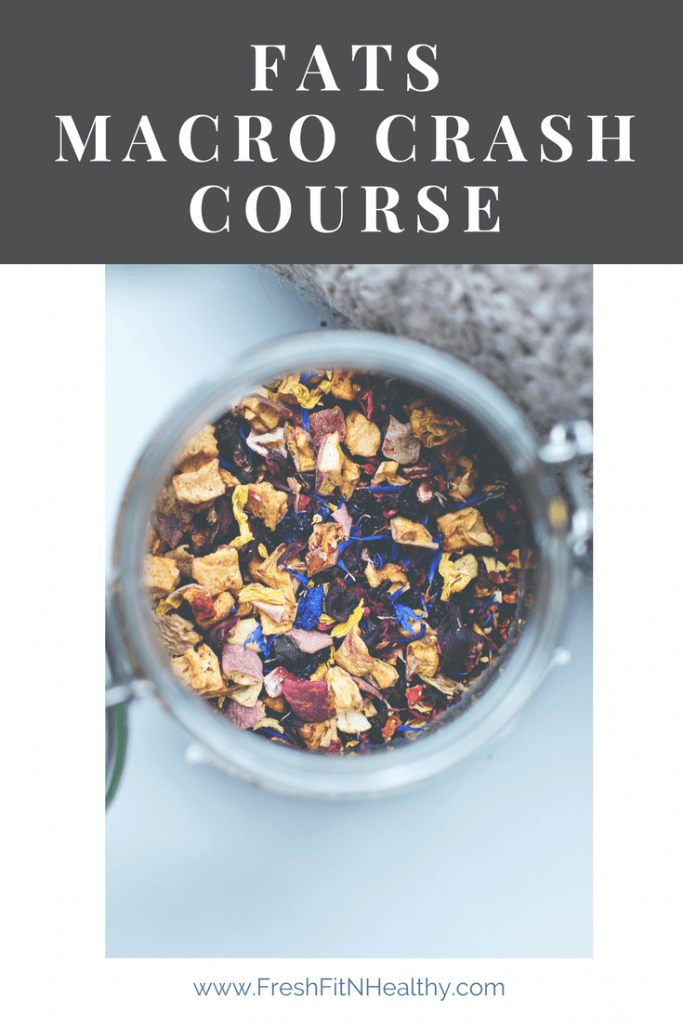Fats are great! Fats make you fat! What is the truth?! Here is a blog post breaking down this important macronutrient: FAT.
It’s PART 3 (and the LAST part) of our macronutrient crash course series. We learned about carbs, then protein, and now FAT. So here is a break down of all things fat: what they are, the types of fat, and examples of the fats you SHOULD be having.
“Fat makes you fat”. “High fat diets are the best for weight loss”. With such conflicting posts out there, what’s right?! Let’s break it all down.

Types of Fats:
There are three types of fat, trans fat, saturated fat, and, unsaturated fat. In this crash course, we will go over each one, what they do, and what health affects they have on the body as well as
Trans Fats
A History
Trans fats are the only true “bad fat.” Not only do they increase LDL (bad) cholesterol, trans fats increase insulin restance—leading to type 2 diabetes, increase inflammation, and cause many other unwanted side effects. This type of fat is found in very small quantities in nature, so small in fact that the effects are negligible. Man made trans fats are a different story.
In the 1900s a German chemist discovered that it was possible to create a solid fat from an unsaturated fat (which are normally liquid at room temperature) by adding hydrogen gas. This process not only changed the chemical properties of unsaturated fats, it extended the life span. For a long time, these hydrogenated oils were believed to be healthier and safer than other types of fats. Butter was switched to margarine, and partially hydrogenated oils were used to fry food. By the early 1900s, it was discovered that these artificial fats raised LDL cholesterol, lowered HDL (good) cholesterol, and caused many other problems. It is now required that foods list trans fat on the ingredient label if they contain them—but not all people look at labels.
So, what are some foods that you should avoid? Anything with ‘partially hydrogenated’ in the ingredient list!
Saturated Fats, Good or Bad?
Similar to trans fats in that both form solids at room temperature, saturated fats often get a bad name. Originally it was believed that consumption of saturated fats would lead to elevated cholesterol levels as well as increase heart attack risk. In 2010, a study in the American Journal of Clinical Nutrition was inconclusive if saturated fats actually caused what it was originally thought they caused.
Other studies have been done since then and nearly all have concluded that no link exists between saturated fats and heart disease. In fact, at the University of Bergen a diet intervention study called FATFUNC found that saturated fat increased HDL—as long as the quality was good. To reword this, saturated fat is healthy as long as it is of good quality.
What does “good quality” mean?
Butter is probably the most well know version of saturated fats. Others include whole milk dairy, beef, ghee, coconut. Just because saturated fat may be okay for you to consume does NOT mean that it is good to go to a fast food joint and pick up a double cheeseburger. The double cheeseburger will be heavily processed and would be more likely to contain the harmful trans fats instead of saturated fats.
If you want to regularly consume dairy products and meat, look for organic and grass-fed. It would be too much detail to explain in this crash course as to why grass fed is better, but take a look at this chart to help you.
Grass fed/organic dairy and meat have more nutrients, less trans fats, are safer to consume, and are overall healthier for you. Let’s not get into the organic vs. not organic debate right now though…let’s focus on the fats!
Types of Saturated Fats:
The most common types of saturated fats are stearic acid, palmitic acid, myristic acid, lauric acid, capric acid, caprylic acid, and, caproic acid.
Stearic acid:
Composed of 18 carbon atoms. Most commonly found in animal fats, cocoa butter, and shea butter. It is used in many skin, hair, and soap products as it helps the oils mix with water. Studies have shown that stearic acid is associated with lowered LDL cholesterol.
Palmitic acid:
This acid is naturally found in dairy, meat, cocoa butter, soybean oil, and sunflower oil. Though present in coconut, this is not the acid that makes coconuts so healthy. Though a component in breast milk and important to life, mompared to other saturated fatty acids, this one should be limited in the diet.
Myristic acid:
This fatty acid, present in nutmeg, palm oil, coconut oil, butter fat, and spermacetin, is good for keeping your skin healthy. Myristic acid works as a lubricant as your skin absorbs it. It is often used in beauty care products for the same reason.
Lauric acid:
Is a form of medium chain triglycerides. Otherwise known as MCT, medium chain triglycerides are beneficial to your health. Most saturated fats contain long chain triglycerides, the difference with MCTs is that the body will process them differently. They are used as a direct source of energy (similar to carbohydrates) and have less calories per gram than traditional fats. If you are looking to increase this acid you can take as a supplement or merely increase your consumption of coconut products.
Capric acid:
Like lauric acid, capric acid is a form of Medium Chain Triglycerides. Along with the benefits of MCTs, capric acid is what provides coconut with its antiviral and antimicrobial properties. Other sources of capric acid are cow milk, goat milk, and palm oil, but coconut is the best out of all them.
Caprylic acid:
Here again is another amazing source of saturated fats. This is a medium chain fatty acid and has antimicrobial/antiviral properties similar to those of capric and lauric acid. It is also antifungal and can be used to treat or prevent candida infections. It is available to take in supplement form, but the best way to reap the benefits is to get this fatty acid from whole food sources.
Dairy products, palm oil, and even peanut butter contain caprylic acid, but again coconut is the best source due to the presence of other important fatty acids and nutritional benefits.
Caproic acid:
Also known as hexonic acid, caproic acid is used in the formation of “esters” in artificial flavoring.
Sum up Saturated Fats
All in all, saturated fats are not the evil that they were originally believed to be. Saturated fats can be part of a healthy diet when consumed in moderation and may even be beneficial to overall health and well-being. It is best to have quality sources of saturated fats such as grass fed dairy and beef, as well as coconut vs. conventional dairy/beef and palm oil.
Unsaturated Fats
There is really no debate with unsaturated fats, they really are beneficial (and necessary) to overall health and well-being. Two types of unsaturated fats exist. Monounsaturated and polyunsaturated fats. Polyunsaturated fats can be divided even further between omega 3 fatty acid and omega 6 fatty acids.
Monounsaturated Fatty Acids (MUFA’s)
You can figure out if something is a monounsaturated fatty acid when they are liquid at room temperature, but start to become solids when refrigerated. MUFA’s have many benefits, they have been found to lower cholesterol, decrease heart disease and cancer risk, anti-inflammatory, and they even have been shown to REDUCE abdominal fat.
Here are some foods that contain MUFA’s:
- Avocado
- Eggs
- Nuts
- Olives
- Peanuts
- Red Meat
And more!
Polyunsaturated Fats (PUFAs)
This unsaturated fat can also be distinguished by the liquid at room temperature/solid in the refrigerator property. Polyunsaturated fats contain omega 3 and omega 6 fatty acids. These acids are both considered essential fatty acids—meaning that the body cannot produce them and they must come from the food that you are eating. PUFA’s have many of the same benefits of MUFA’s such as increasing HDL cholesterol and lowering LDL cholesterol, anti-inflammation, and have positive effects on the heart. PUFA’s have positive affects on the brain and cognition and are greater at reducing inflammation than even MUFA’s. Let’s go over the two types.
Omega 3 There are three types found in food Alpha-linolenic Acid (ALA)—plant based—Eicosapentaenoic Acid (EPA)—needed in high amounts but your body is able to synthesize it from the original form—and Docosahexaenoic Acid (DHA)—necessary to obtain from your diet as it is only found in foods such as oily fish. Omega 3s contain many benefits and it is recommended that you consume a minimum of 200-500mg a day of EPA and DHA fatty acids.
Some foods that contain omega 3s:
- Anchovies
- Chia Seeds
- Cod liver oil
- Flaxseeds
- Herring
- Mackerel
- Salmon
You may notice a common theme here…fish. Oily fish contain high amounts of omega 3s so try adding some more fish into your diets to reap the benefits.
Omega 6 These fatty acids do have their benefits, but unfortunately the American diet is too high in these fatty acids relative to the intake of Omega 3 fatty acids. When the ratio of omega 6 to omega 3s become too high it can cause inflammation.
Foods high in omega 6 include:
- Corn oil
- Cottonseed oil
- Grapeseed
- Poppyseed oil
- Safflower
- Sesame oil
- Soybean oil
- Sunflower oil
- Walnut oil
Many fried and processed foods contain these fatty acids. By reducing your intake of processed and unhealthy foods, you will lower your consumption of omega 6 fatty acids.
In Summary
Unsaturated—and even saturated—fats make up an important part of a healthy diet. A healthy diet should contain about 25-30% fat. The majority should come from unsaturated fats but having a low level of saturated fats can also be beneficial, Trans fats should be eliminated. It is important to eat foods containing omega 3 fatty acids, such as oily fish, to prevent deficiency.
If someone does not eat fish or foods containing omega 3 (such as vegetarians or vegans) they should take a supplement. As far as saturated fats go, they are not all bad as once thought and have many benefits. If you are trying to increase intake of saturated fats coconuts are an excellent source. Still, intake should be limited.
However, as I preach here and on my instagram and everywhere else, it’s all about finding what works best for YOU. Some people thrive on a high fat diet. Others don’t. Some people’s body react positively to a ketogenic diet, others don’t. For some people’s lives, that kind of diet is practical and easiest – for others it isn’t.
If you want to figure out a personalized plan for YOU, click here and apply to work with me 1-1.
Check out some healthy fat packed recipes here:
- Dark Chocolate Mousse (made with a secret ingredient)
- Avocado Dip
- Almond Butter
- Peanut Butter
- No Bake Peanut Butter Balls
